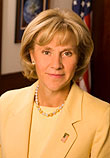 Two months ago, I began a great, new adventure into the world of science policy and advocacy at Research!America. As I had come from the medical research scene at the National Institutes of Health, I figured I would be in for quite a change, and I was pleasantly surprised.
Two months ago, I began a great, new adventure into the world of science policy and advocacy at Research!America. As I had come from the medical research scene at the National Institutes of Health, I figured I would be in for quite a change, and I was pleasantly surprised.
Right away, there were meetings with political figures like Representative DeLauro and the Surgeon General, discussions of currently controversial topics like stem cell research and the federal budget, and advocacy work that ranged from creating state fact sheets to expanding our grassroots advocate network. In contrast to culturing cells, pipetting solutions, reading science articles and communicating results with other scientists, science policy is much more political and far less technical. How have I coped with such changes?
I quickly found that certain skills I acquired in the lab did come in handy. Personal communication is most important. In research, I communicated with my lab mates and other collaborating researchers in person or by e-mail all of the time. In policy, I had to communicate with my co-workers and our advocates in the same formats, but the language used was very different. Science is filled with technical jargon that can quickly confuse a non-scientist, so I had to search for more appropriate ways to get my points across. Instead of saying something like “genetic manipulation,” I might say “making changes to DNA.” It was tricky at first, but I learned that it makes discussions with those not having a science background so much easier.
Another useful skill is writing. Again, much of my writing in research was geared towards a scientific audience. Writing for research advocacy involves reducing science into its practical meaning for the given audience. If I were speaking to scientists, I would discuss my research data very technically, but if I were speaking to economists, for instance, I might focus on how finding new drugs can help companies generate profits and create more jobs. At Research!America, we write advocacy messages of many forms to show politicians and the public how federally funded medical research is important for creating new drugs, surgical devices and procedures and jumpstarting the nation’s economy.
Last of all, I want to mention that negotiation is undeniably important. In life, people negotiate all the time whether it’s where to go for lunch or how much to pay for something. In politics, everything is negotiating, but not everyone is skilled at it. In research, I might have negotiated whether I should or shouldn’t do certain experiments. In advocacy, I am always negotiating for support whether it is from people in the office or new advocates in Congress and the public. Getting others to donate time for a good cause is not as easy as I once thought. It takes some careful negotiating by telling people what they could gain with their efforts. In this case, more research support from the federal government is the prize.
Overall, I have had a tremendous experience at Research!America. The people I’ve met are very helpful and wonderful at what they do, and the personal skills I’ve developed will be very useful in the future. I would like to offer my deepest thanks to our Science Policy and Advocacy team of Mary Woolley, Ellie Dehoney, Max Bronstein, Bill Leinweber, Vidusha Devasthali, Michelle Hernandez and our former colleague, Heather Benson as well as everyone else within Research!America. Without all of you, this experience would not have been as great!
The New Voices blog will be ending this week. The blog archive will continue to be available online, but we will not be adding new content. Thank you all for your interest and support over the years. On Friday, we’ll be posting information on how to remain engaged with Research!America and our advocacy efforts.




 Diabetes
Diabetes











